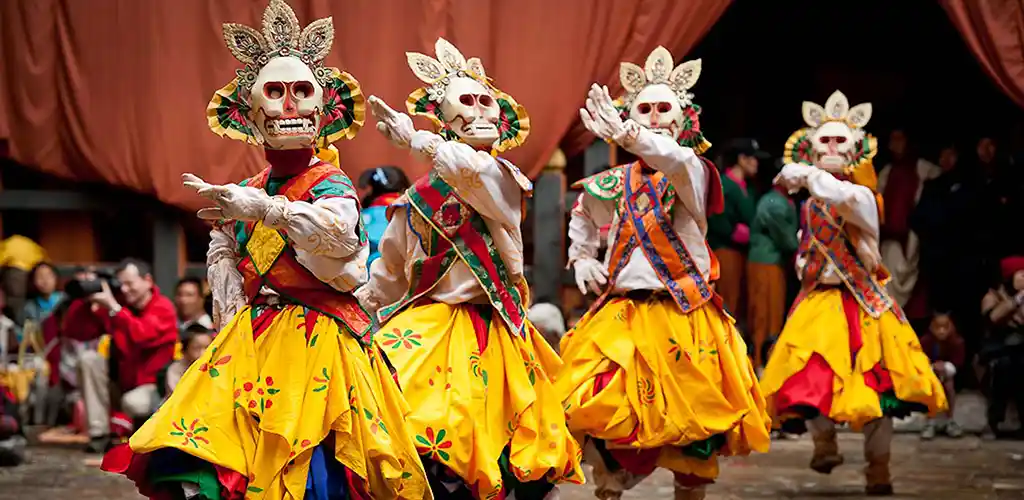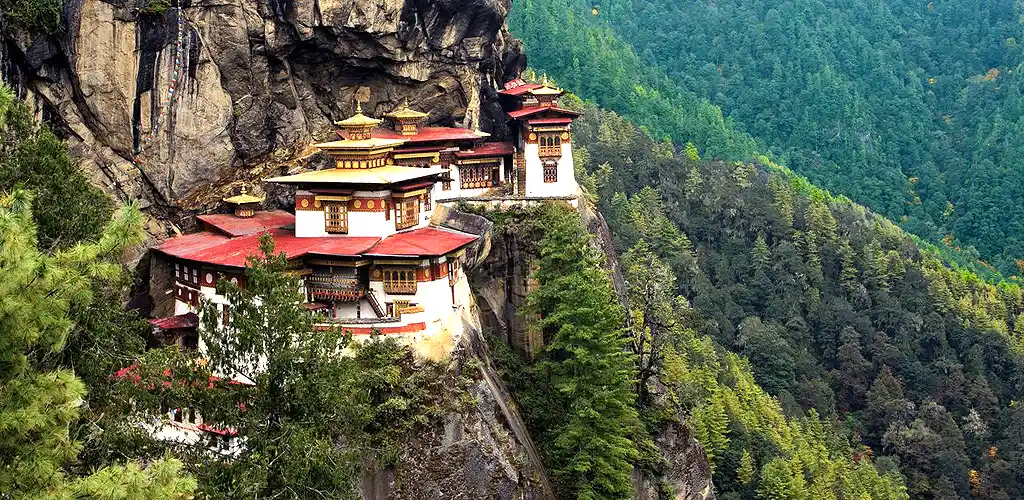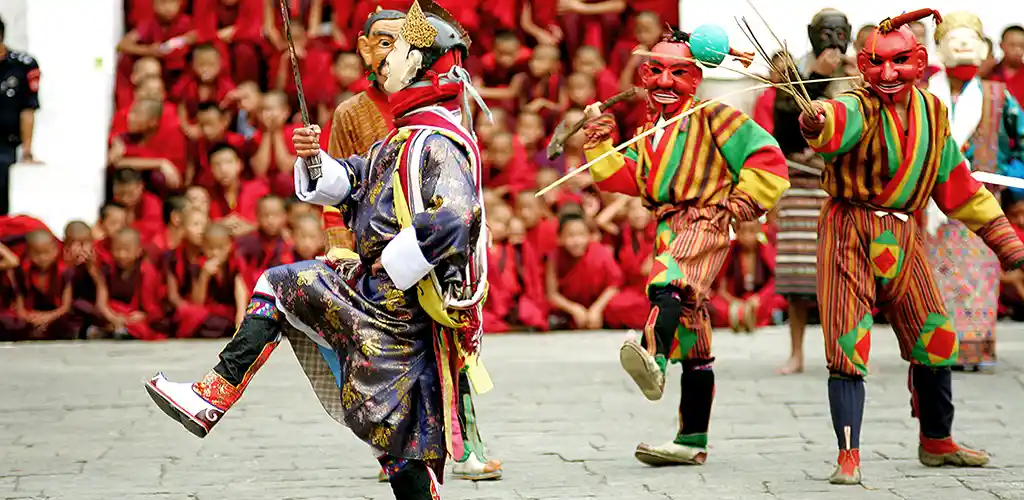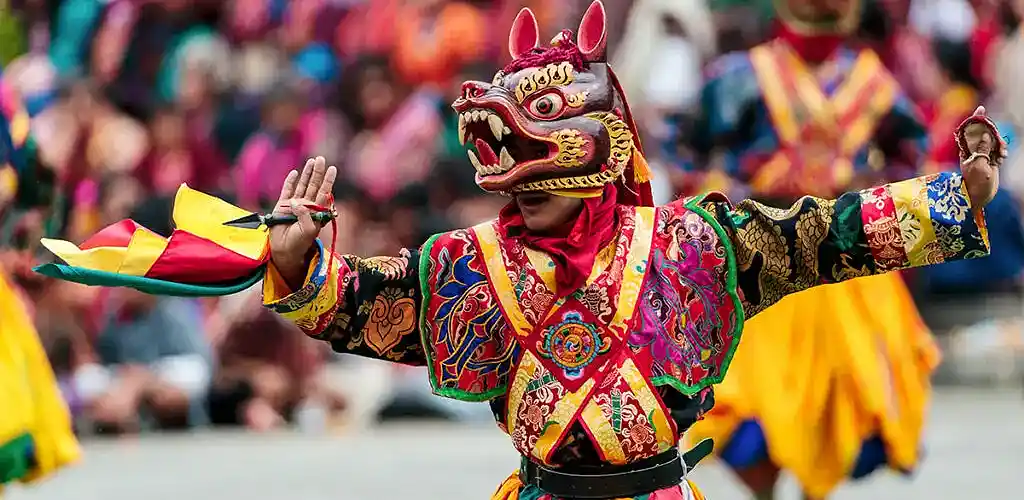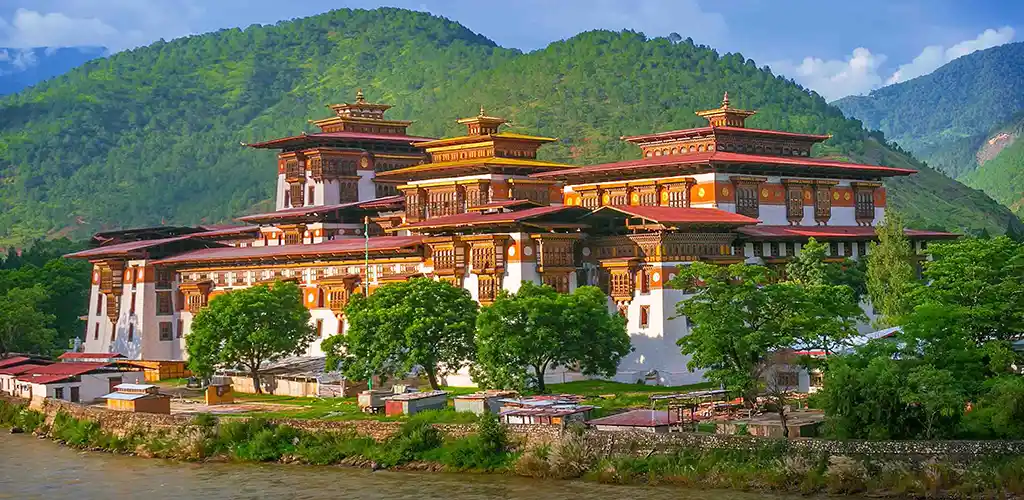Bhutan Festivals
Festivals in Bhutan are such unique and profound spectacles that you should plan your visit to take in at least one during your travel there. Festivals are held all over the country held in sacred dzongs (fortress) or monasteries and take place in the spring, after weather warms, or in the fall after monsoon rains. Let us plan a visit not only to a major festivals listed below, but also smaller more intimate secondary ones during the festival season that are not listed here.
The photography trip you organized for me was the most memorable of my life—Tim Johnson
By attending tshecu, one gains merits in seeking forgiveness for their sins in life. During the festivals masked and historical folk dances in colorful costumes are performed by monks and laymen including Atsaras (clowns) amusing the audience with their antics. Tsechus feature a variety of traditional dances with specific significance (see our Thimpu Festival or Wangdue Festival pages for detailed descriptions). As one would expect, tshechu are also a very important occasion for social gatherings of families, villagers, and peoples from throughout an area, attending dressed in their finest traditional clothes and jewelery, all making for a fascinating time to visit the country.
Popular annual festivals in Bhutan are listed below, although we encourage and plan for you to attend smaller, lesser-known ones that can be more intimate. Dates are approximate, and change seasonally. With careful planning, we may also arrange for you to attend more than one event.
Jampa Lhakhang Tshechu
Jampa lhakhang is one of the oldest temples in Bhutan, founded by, Songtsen Gampo, a Tibetan King in the 7th century, who according to legend, built 108 temples on and across the border of Tibet in one day to subdue the demoness residing in the Himalayas. It also hosts the Dus Kyi Khorlo (Kala Chakra- Wheel of Time) built on the command of first king, Gongsa Ugyen Wangchuck to commemorate his victory over his rivals, relics of future Buddha, and statue of Jowo Jampa. Frequent visits by Guru Padmasambahava and Chakhar Gyab (king of the iron castle of Bumthang) while renovating the temple raised the sacredness of this temple even more.
At Jambay lhakhang Drup visitors can witness the mewang ceremony—a fire ritual and dance.
JANUARY | BUMTHANG
Punakha Drubchen & Tshechu
The Punakha Drubchen commemorates victories over the Tibetans. Drubchen is the meditation practice of in Tibetan Buddhism with prayers being chanted 24-hours a day throughout the festival. This tsechu is unique in presentation, with Pazaps (local militia men) dressed in battle gear showcase an ancient battle scene when, in the absence of an army, local men of Thimphu drove Tibetan forces out of Bhutan, bringing peace and stability in the country. The Punakha Tshechu, however, is a recent phenomenon, instituted only in 2005 to memorialize the noble deeds of Zhabdrung Rimpoche and in reverence of the two man protective deities of Bhutan (Yeshey Gampo and Pelden Lhamo). A magnificent and one of the largest Thongdrel (sacred tapestry) is unfurled at the festival's end.
FEBRUARY/MARCH | PUNAKHA
Chorten Kora Tshechu
Chorten Kora monastery is one of the most significant Buddhist structures in Bhutan, built as a replica of the Boudhnath stupa of Nepal in 1740 by Lama Ngawang Loday in memory of his late uncle and also to subdue a demon that lived where the chorten stands today. Myth has it that on the 15th day of the first Bhutanese month, a young girl believed to have been a Khando (sky-dancer or female reincarnation of god/godess) agreed to be buried alive as the nangten (main relic) of the Chorten. For this reason a ritual known as Dakpa Kora is organized every year where hundreds of people from Arunachal Pradesh known as the Dakpas make it to Chorten Kora to circumnavigate.
FEBRUARY/MARCH | TRASHIGANG
Gomphu Kora Tshechu
Gomphu Kora monastery is located in Trashiyangtse, two hours east of Trashigang. Gomphu in local language translates to “Meditation Cave” and Kora to “Circumambulation,” named Gomphu Kora from a cave formed out of a rock-face next to a temple that has been built as a tribute to the sacred site. Legend has it that in the 8th century an evil non-human spirit named Myongkhapa escaped from Samye in Tibet when Guru Padmasambhava, the great Nyingmapa scholar (the oldest of the four major schools of Tibetan Buddhism) was spreading the Dharma in the Himalayas. Myongkhapa followed the course of the present-day Kholongchhu stream and hide himself inside a rock where Gomphu Kora stands today. The Guru followed the evil to the cave, mediated there for three days and finally subdued it. The sacredness of this Tshechu is in its circumambulation for there is even a local saying “Go around Gomphu Kora today for tomorrow may be too late”.
MARCH/APRIL | TRASHIGANG
Paro Tsechu
Convenient and popular, the Paro Tsechu is easy to combine with a second festival during your trip. The climax of the Paro Tsechu is the unfurling of the world’s biggest Thangka, a large sacred tapestry, of Guru Padmasambhava followed by dance of the Lord of Death (Shingje) and his consort, dance of the black hats (Shanag), dance of the drum (Drametse Ngacham), dance of the eight kind of spirits (De gye mang cham), and other traditional songs and dances.
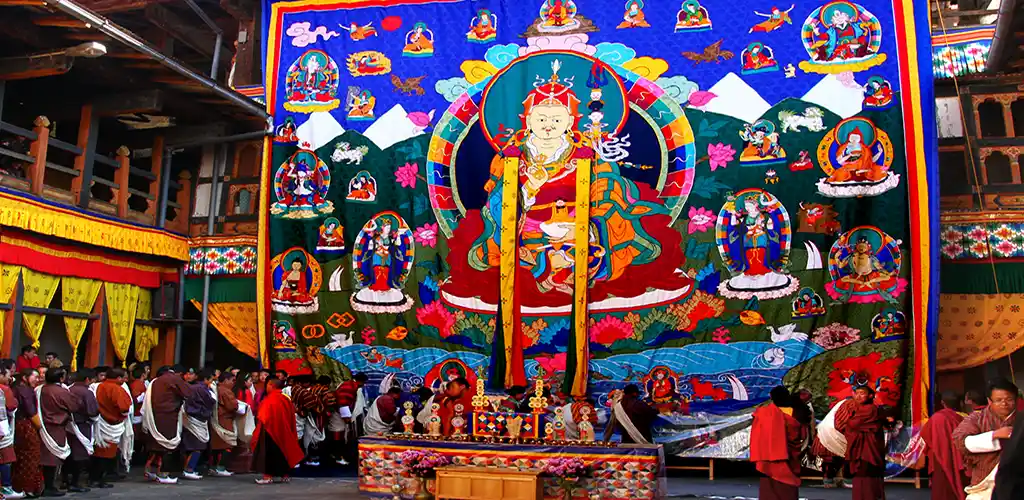
Ura Yakchoe
Ura Yakchoe is a celebration of Yaks by the people of Ura in Bumthang, who are mostly sheep and yak herders. People from this region as well as others come together to share food and products and to receive blessings from the relic which according to myth was a statue left at the door step of a woman by a great lama. It is a joyous ceremony with lot of dancing and singing; plays on the life of Guru Padmasambava and other great saint and the highlight being the yak dance which can only be seen here.
APRIL/MAY | BUMTHANG
Kurje Tshechu
Kurje lhakhang is one of the sacred temples of Bhutan. Its history refers back to the time when Guru Padmasambava visited Bhutan to heal the ailing King Sindhu Raja who was then the king of Bumthang. Legend has it that in order to subdue the demon that was causing illness to the king, Guru meditated in a cave that resembled pile of Vajras (thunderbolt of enlightenment). After subduing the demons, imprints of Guru Padmasambava’s body remained. This is how the lhakhang got its name Kurje meaning imprint of the body. Kurje festival is an important festival for local people of Bumthang and rest of the Bhutanese alike because of its sacredness, blessings, and uniqueness. The age old mask dances and other traditional Bhutanese dances showcasing the unique culture of Bumthang are simply beautiful.
JUNE | BUMTANG
Merak & Sakten Tshechu
Merak and Sakten valley located in the eastern most part of Bhutan in Trashigang is home to the semi-nomadic people known as Brokpas. Situated at nearly 3,000 meters, these two valleys still remain isolated from the outside world with locals earning their livelihood by rearing Yak and sheep, exchanging its by-product with rice and other necessities. A unique facet of their culture is female polygamy, an common for Brokpa women to marry all the brothers in a family. Merak Tshechu and Sakten Tshechu are celebrated differently at Merak Lhakhang and Sakten Lhagang respectively. However, both the tshechus provide the brokpas with the much needed respite from their daily chores at the mountains to come together and commemorate their local deity. The tshechus also show case exclusive Yak dances and other brokpa dances attracting am increasing number of visitors every year.
AUGUST | TRASHIGANG
Thimphu Drubchen and Tshechu

One of the biggest festivities celebrated in the capital city taking place over four days. The Tshechu begins with Lhamoi Drubchen, a rite dedicated to the protecting deity of Bhutan, Pelden Lhamo. Pelden Lhamo as the name translates; Glorious Goddess is the only female dharma protector and one of the three main protecting deities of Bhutan. The actual Tshechu begins the next day in the large courtyard at the Tashichho dzong for following three days whereby various mask dances both in the form of peaceful and wrathful figures are displayed to commemorate the anniversary of Guru Padmasambhava and for the well-being of attendees.
SEPTEMBER | THIMPU
Wangdiphodrang Tshechu
Similar to Punakha Tshechu, the annual Wangdiphodrang Tshechu was also instituted by Zhabdrung in the 1600’s. It is a three day Tshechu starting from 10th day of every eighth lunar month. The highlight of this Tshechu is the Raksha Mangcham (dance of the Ox) and unfurling of old Guru Tshengye Thongdrel (tapestry of Gurus eight manifestation).
SEPTEMBER/OCTOBER | WANGDUE
Thangbi Mani
One of Bhutan's most popular festivals, featuring thrilling fire dances. During the 7-day tsechu, monks perform purification rituals and local people jump over flames in purification ritual. Several tradtional Cham mask dances and folk dances are also performed by the monks and local people to bring peace and prosperity, while ensuring better harvest for the entire community.
SEPTEMBER/OCTOBER | BUMTHANG
Wangdue Tshechu | Wangdue (September/October)
Wangdue's 3-day Tshechu festival of mask and folk dances was founded by the 4th Temporal Ruler of Bhutan, Mr. Tenzing Rabgye (1638-1696), to commemorate the birth of Guru Padmasambhave. The Tshechu features dance by monks and laymen, and on the final day, the display of the huge and colorful thangka, a painting on silk with embroidery. The Annual Wangduephodrang and Wangdue Tshechu were held at Wangdue Dzong, which sadly burned to the ground in June, 2012. That year it was re-located to the Tencholing Military Training center. Fortunately, reconstruction of the new Wangdue Dzong has been nearly completed with the festivals return in 2023.
![]() READ ABOUT THE WANGDUE TSHECHU
READ ABOUT THE WANGDUE TSHECHU
SEPTEMBER/OCTOBER | WANGDUE
Jakar Tshechu
A relatively new festival, and also more remote to travel to, the five-day long annual Jakar Tshechu is held every October to November and takes place within the magnifcent Jakar Dzong ("Castle of the White Bird") with a dramatic location overlooking the breadth of Bumthang’s Chamkhar Valley. Traditional dances include the Black Hat Drum, Wrathful War, Dance of the Terrifying Deities, Stag and Hounds, Dance of the Lords of the Cremation Grounds, and the dance of the eight manifestations of Guru Rinpoche.
![]() READ MORE ABOUT THE JAKAR TSHECHU
READ MORE ABOUT THE JAKAR TSHECHU
OCTOBER/NOVEMBER | BUMTHANG
Trashigang Tshechu
Trashigan Tshechu is the only festival performed in the winter months and is one of the remotest. Since, it is the largest district in the country and the home of the Tsanglas, the aboriginal inhabitant of the district, people from all community: Brokpas, a semi-nomadic community from Merak Sakteng, Khengpa from Zhemgang, and people from as far as Samdrup Jongkhar and Pema Gatshel attend the Tshechu. It is an excellent opportunity to mingle with people from different community of eastern Bhutan. The unfurling of Neten Chudrung (Sixteen Arhats) Thongdrel on the 5th day and old thongdrel of Guru Tshengye (eight manifestations of Guru Padmasambhava) on the final day is the main connotation of this Tshechu.
NOVEMBER | TRASHIGANG
Black-Necked Crane Festival
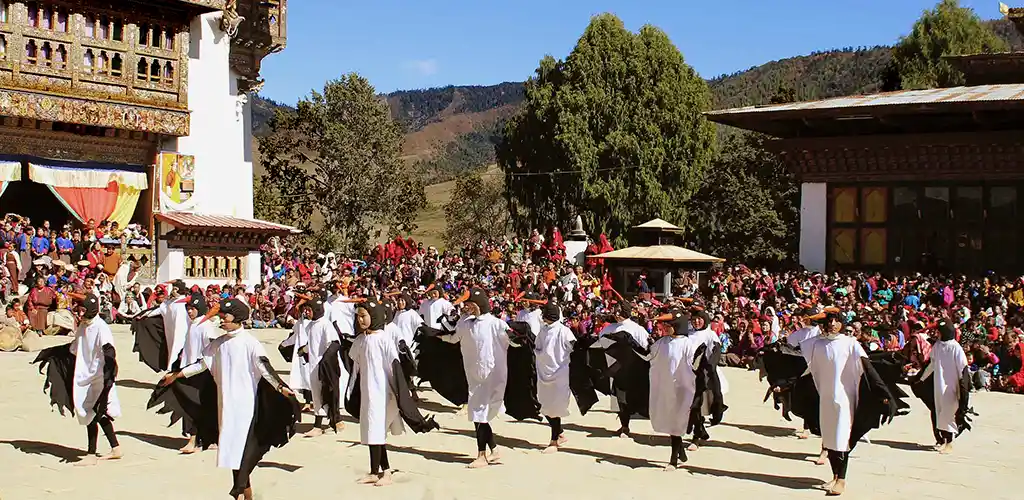
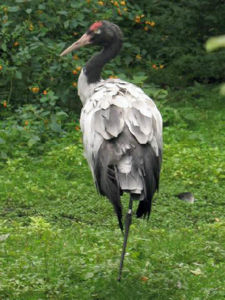 Bhutanese believe the rare cranes are sacred Bodhisattvas and monks pray for their return each year from Tibet. Only a few hundred rare and endangered black-necked cranes arrive into the picturesque Phobjikha Valley (also called Gangtey Valley) from Tibet plateau each year at the end of October. The the cranes are revered in Bhutan and the government operates an information center in the valley with learning materials and telescopes to view the birds. An annual Black-Necked Crane Festival occurs in early November. Their safe arrival into the beautiful Phobjika Valley celebrated and cause for the annual festival held at the Gangtey monastery.
Bhutanese believe the rare cranes are sacred Bodhisattvas and monks pray for their return each year from Tibet. Only a few hundred rare and endangered black-necked cranes arrive into the picturesque Phobjikha Valley (also called Gangtey Valley) from Tibet plateau each year at the end of October. The the cranes are revered in Bhutan and the government operates an information center in the valley with learning materials and telescopes to view the birds. An annual Black-Necked Crane Festival occurs in early November. Their safe arrival into the beautiful Phobjika Valley celebrated and cause for the annual festival held at the Gangtey monastery.
The local monks perform dances to themes related to the cranes and a highlight of the festival are delightful dances by local children dressed in crane costumes and the monastery is ideally located above the valley on the Phobjika Nature Reserve where hundreds cranes spend the winter. This is one of our favorite festivals, for the cranes, but also the low-key atmosphere of this smaller, less venerated Tsechus. The smaller crowds allow for up close watching of the ceremonies and better chances for photography.
NOVEMBER | WANGDURPHODRANG
Lhuentse Tshechu
Lhuentse is one of the remotest and economically poorest districts in Bhutan, nevertheless with a rich history and local culture. People from Lhuentshe are referred to as Kurtoeps in local language and every kurtoeps boasts of their region as birthplace of the present Monarchs and Kushithara (beautiful design of the attire worn by Bhutanese women). Some notable festivals held in Lhuentse are the Cha and the Haa festivals that are celebrated annually to pay respect to the deities and to remove misfortunes. The Tshechu is normally celebrated in the month of November and it’s a great opportunity to view and receive blessings from some of the important relics that are rarely publicly displayed.
DECEMBER | WANGDURPHODRANG
Why choose Indochina Travel? We take you to places, organize experiences, and introduce you to local people that no one else does. Whether celebrating an anniversary or planning a family trip, our journeys offer unforgettable experiences in Bhutan, Land of the Thunder Dragon
